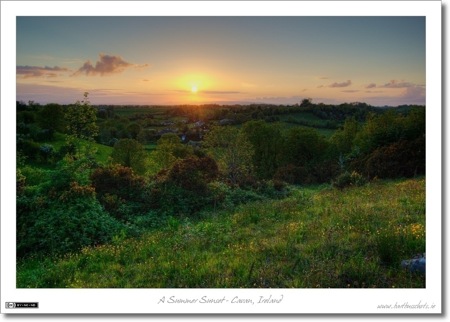Jul
4
Photo of the Week 71 & 72 – A Cavan Sunset
Filed Under Photography on July 4, 2009 | 4 Comments
I’ve found myself one week behind yet again, so, for what seems like the millionth time, I’m doing a double-post this weekend. As always with these multiple posts, I’m choosing two related photos, in this case, VERY related photos, they were both taken within a few minutes of each other of the very same subject! The reason I’ve chosen to do these together is because they show two approaches to the same situation.
When you shoot a sunset the dynamic range is exceptionally high. You are shooting into the sun, and at the same time, the ground is getting dark, so, you have a very bright subject, with very dark surroundings. The range between the brightest and darkest range of the scene is just too big for a camera to take in. This leaves you with a choice between two approaches, both of which can make for fantastic photos.
As a complete geek, my first reaction is to throw technology at the problem. Although the technology I threw at the problem is quite modern (HDR photography), the idea is not new. In the past people would use graduated filters to solve the same problem. With a graduated filter the top of the filter blocks quite a lot of light, the bottom, none. You can get filters that have very abrupt graduations where half the filter is dark, the other half completely transparent with a very short transition between the two regions, or you can have filters that go smoothly from dark to light over the entire length of the filter. Different situations will call for different filters, but the aim is the same, get both the bright bits and the dark bits properly exposed despite the large difference in brightness between them (i.e. the large dynamic range). I don’t own any filters, so that’s not what I did. Instead, I used a technique called Tonemapping on a RAW file. The result is that you can see detail in both the bright sky and the dark landscape in this shot, which is the first of my two photos for this week:
- Camera: Nikon D40
- Lens: Nikon DX AFS 18-55mm (D40 kit lens)
- Exposure: 1/320 sec
- Focal Length: 18mm
- Focal Ratio: f/8
- ISO: 200
- Camera Mode: Aperture Priority
- Exposure Bias: -1.0EV
- Processing: Generated by tonemapping a single RAW file in Photomatix Pro.
So that’s an example of taking the first option for dealing with a high dynamic range, use technology to get around it. So what’s the second option? Don’t fight it, accept it, and use it! If you can’t get everything exposed properly, don’t even try, instead, intentionally only expose for one element. With a sunset that one element is the sky, and then you intentionally throw the rest into silhouette. You intentionally take away all exposure in your foreground! This can result in a lot of black space in your image, so you often have to crop pretty hard to make this work well. An example of this is the second image I’ve chosen for this week:
- Camera: Nikon D40
- Lens: Nikon DX AFS 18-55mm (D40 kit lens)
- Exposure: 1/640 sec
- Focal Length: 55mm
- Focal Ratio: f/8
- ISO: 200
- Camera Mode: Aperture Priority
- Exposure Bias: -2.0EV








